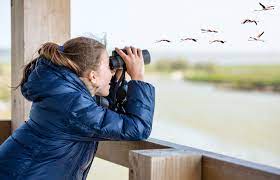Introduction
Quick Navigation
Bird watching is the practice of observing birds in their natural environment. It is a type of wildlife observation whereby specialists study birds in their native habitats with their naked eyes or with the aid of enhancement devices such as telescopes and binoculars. Bird watchers observe birds by listening for bird sounds or by watching public webcams. It is otherwise known as birding. There are people who do birding for fun, and there are others who make a career in bird watching. Hence, there are professional birders across the world. Because birds are more readily noticed by ears than by eyes, bird watching involves excellent or good hearing rather than sight capability. Bird watching is a pastime, and is therefore different from ornithology which is the science of studying birds using the scientific methods.
History of Bird Watching
The sequential history of bird watching appears to be unavailable. However, it appears that the study of birds, natural history, and ecology in general became prevalent in Britain in the Victorian Era. This involved collection of birds, skins of animals, and artifacts. Bird watching as a pastime dates back to around late 19th century. This is contained in the books of writers such as John Clare, George Montagu, Gilbert White, and Thomas Bewick. Around this time, people saw bird students using guns to hunt and scare birds. It was during the 19th century when there was a call for the conservation of living bird species that observation of birds as a pastime began in different regions across the world. The awareness on the need to preserve bird species was a welcome one as it led to the emergence of decrees, acts, and legislations for the conservation of bird species across different regions. This also facilitated the establishment of governmental and non-governmental organizations that were geared towards operationalizing the call for preservation. Several books were also written by individuals to document bird species in different regions, how the birds were being endangered, and to sensitized people on the importance of bird conservation. In Britain, the Royal Society for the Protection of Birds was established while in the United States, Audubon Society and American Ornithologists’ Union was formed.
The first book where ‘bird watching’ first appeared was that by Edmund Selous, published in 1901. Birding in North America began in eastern seaboard region, and was greatly enhanced by the invention of optical devices
and field identification guidelines such as that by Florence Bailey titled ‘Bird Through an Opera Glass’ published in 1889. In the United Kingdom, groups of birdwatchers began to form rapidly, and by late 1930, the British Ornithology Trust for Ornithology was formed. The British Trust for Ornithology had similar interests to the American Ornithologists’ Union, and both employed scientific methods in studying birds. Also both of them produced scientific results that greatly enhanced familiarity with bird species. Over hundreds of centuries, many birding associations and field guides have emerged in different regions and places across the world.
What Bird Watchers Do
Bird watchers are people who specialize in observing birds either as a pastime or as a career. They spend their time observing local birds primarily to gain familiarity with them such as their habits, lifestyles and features. However, birders also get better acquainted to various elements of nature that they encounter while they are doing their job. Bird watchers also may travel away from their countries or regions of nativity to other territories to do their job.
Bird watching is seasonal and varies from one region to another depending on the prevailing climate. This is because birds are seasonal animals and tend to migrate in large flocks between widely separated locations, sometimes traveling several miles or kilometers. For instance, in the temperate regions, birding is best done during the spring or fall season when large flocks of diverse species of birds migrate to nesting locations, and are readily observed. In such seasons, mornings are most suitable to observe birds because they are most active and vocal at such times of the day. Manu National Park, Peru is among the best bird watching sites in the world.
Tips on Bird Watching
Avoid noise. Birds are vigilant creatures, and are readily startled by noises and screaming. They are most likely to flee away making screeches when they perceive startles.
Do not make sudden movements. Birding involves stalking rather than jerking. It should be done carefully and vigilantly so as not to scare the birds away.
Learn to follow to calling birds. Calling birds are birds, usually two or one, that signal to a flock of birds to alert them about impending threat or danger. Following such a bird can be very helpful in getting to larger flocks.
Learn to study habitats. Because different species of birds are adapted to specific habitats, it is important first to study any one habitat to gain some first-hand familiarity with the particular species of bird.
Take time to examine the flock. When you encounter a bird flock, chances are higher to notice more than one species rather than a single species. One or more birds of other species might just mingle with a flock of another species for food or protection.
Do not be in haste. Bird watching requires devoting oneself to wait and watch birds as they show up and display in their habitats. So it requires a lot of patience.
Get the sun at your back. When bird watching it is important to move around so as to get radiation from the sun behind you rather than from the front.
Do not wear brightly-colored clothes. Rather than brightly colored clothes, it better to dress in dull-colored clothes that blends into the background just to deceive the birds to remain perching.
Look around. Try as much as you can to look beyond only one target. Looking around makes a bird watcher to observe more bird species. ‘Pishing’ also helps to force birds out of their hideouts.
Conclusion
Bird watching is both exciting and tasking. However, the excitement and benefits inherent in the activity can always outweigh its challenges especially when it is done cheerfully. Interestingly, with the modern technology, bird watching can be a more appealing activity today.

